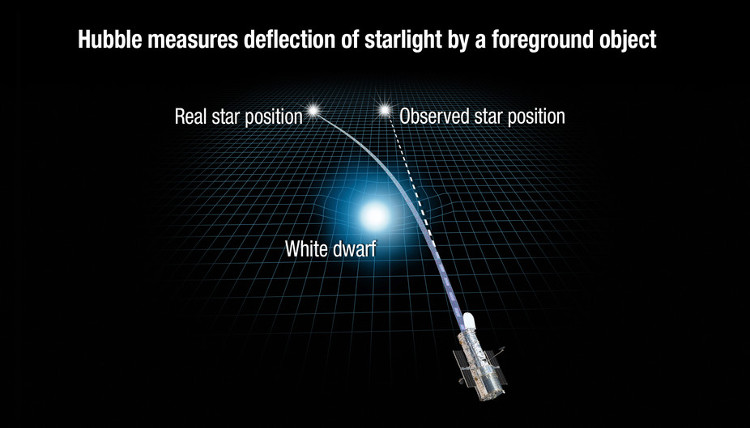For the first time, the scientific community determined the mass of a star
More than 100 years after Albert Einstein's physics genius successfully developed general relativity, astronomers also successfully applied this theory to first determine the mass of a distant star - something but scientists have long believed that it was an "impossible" task .
In a study published in the June 7 issue of the American Journal of Science, Hubble Space Telescope researchers have revealed how gravitational white dwarfs bend space. and bend the light of a distant star behind it. Thereby, the researchers first determined the mass of a star with this gravitational force.
One of the main predictions of general relativity developed by Einstein in 1915 is that whenever light from a distant star passes a closer object, gravity acts as a kind of glass. magnify, lighten and meander that star. Einstein points out that such a phenomenon is called a weight lens , leading to a perfect ring of light - a so-called "Einstein ring".

The researchers estimated the mass of the white dwarf Stein 2051 B is only 68% of the Sun.
The first evidence of the bending of light appeared as an eclipse in 1919. This helped provide one of the first compelling evidence of Einstein's theory of relativity. But Einstein also predicted that if two stars were not on the same axis, it would make the background star appear outside the center in a way that could be used to directly determine the mass of the moon star. However, in a scientific article in 1936, he added that because the stars are so far apart, "there is no hope of directly observing this phenomenon".
In the current study, an international research group led by scientist Kailash Sahu of the Space Telescope Science Institute in Baltimore took advantage of the Hubble Space Telescope's maximum angular resolution and actively sought over 5,000 so that the link is not the same axis. Scientists found that the white dwarf Stein 2051 B was placed in only one position in March 2014 and then towards the Hubble Telescope observing the phenomenon, measuring small changes in a clear position. of a background star behind it. Based on the above data, the researchers estimated that the mass of this white dwarf is only 68% of the Sun.
Embry-Riddle, Terry Oswalt, said: "Einstein will be very proud when one of the important things he mentioned was undergoing a rigorous supervised test . " According to Oswalt, these findings are significant because "at least 97% of all stars that have formed in the Galaxy, including the Sun, will become or have been white dwarfs based on that. We can know about the future, as well as our history. "
- Why does the star system have 3 super new Earth?
- Deadly giant stars swallow their companions
- The mysterious age of the mysterious star
- For the first time, a star has been discovered in a star
- Detects aluminum around a new star thanks to the ALMA telescope
- Found a new type of black hole, hidden in dense star clusters
- Detecting unprecedented neutron stars, challenging the physical limit
- Green Land received the Vietnam Gold Star Award 2013
- 7 super interesting scientific knowledge that we missed while at school
- Discover a mysterious companion star
- Discover three new 'Super Earths' around the star LP 415-17
- Earth swells like a ball - Deception in science (Term 2)
 Van Allen's belt and evidence that the Apollo 11 mission to the Moon was myth
Van Allen's belt and evidence that the Apollo 11 mission to the Moon was myth The levels of civilization in the universe (Kardashev scale)
The levels of civilization in the universe (Kardashev scale) Today Mars, the sun and the Earth are aligned
Today Mars, the sun and the Earth are aligned The Amazon owner announced a secret plan to build a space base for thousands of people
The Amazon owner announced a secret plan to build a space base for thousands of people